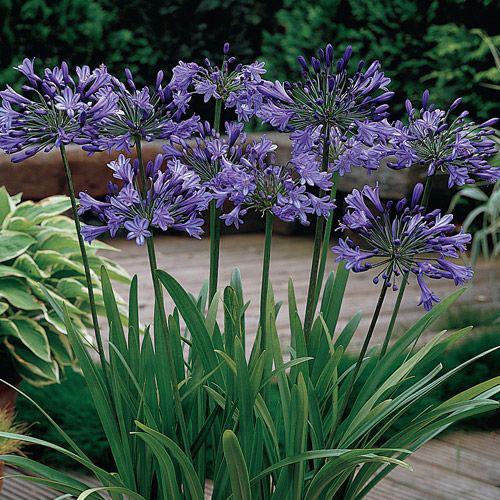Releasing the Secret to Effective Agapanthus Growing: Advice for a Flourishing Yard
In the realm of horticulture, growing agapanthus successfully requires a calculated technique that includes various facets of plant care. By comprehending the nuances of agapanthus cultivation, one can create a setting where these plants grow and grow abundantly.
Growing Agapanthus: Best Practices
When growing Agapanthus, proper dirt preparation is necessary for ensuring effective development and development of these beautiful flowers. Agapanthus, generally understood as Lily of the Nile or African lily, prospers in well-draining soil with a somewhat acidic to neutral pH level - Agapanthus. Prior to planting, it is critical to amend heavy clay soils with raw material such as compost or peat moss to improve drain and provide vital nutrients for the plants
To plant Agapanthus, select a place that obtains full sunlight to partial shade, as this will promote healthy growth and plentiful flowering. Dig an opening twice the size of the plant's root sphere and put the Agapanthus at the exact same depth it was previously growing. Gently backfill the hole with soil, pressing down securely to eliminate any type of air pockets around the origins.
Water the recently planted Agapanthus completely and proceed to maintain the soil uniformly damp, particularly throughout the plant's energetic growing season. Agapanthus. Applying a balanced plant food once a month can additionally sustain the plant's growth and blooming. By complying with these finest techniques for growing Agapanthus, you can develop a sensational screen of these exciting blossoms in your yard
Suitable Dirt Issues for Agapanthus
For ideal development and growing success of Agapanthus plants, guaranteeing the dirt problems are perfect is important. Agapanthus favors dirt that is rich in nutrients, so integrating a balanced plant food during the growing season can promote healthy and balanced development and dynamic blossoms.

Watering and Fertilizing Tips
To make certain healthy growth and vibrant blooms, proper watering and fertilizing techniques are essential for successful Agapanthus growing. Agapanthus plants profit from routine watering, especially during the growing season.
When it involves feeding Agapanthus, a well balanced fertilizer with equivalent components nitrogen, phosphorus, and potassium can be used in the springtime to promote healthy growth and flowering. Slow-release fertilizers are optimal for offering nutrients progressively over an extensive period. Avoid over-fertilizing, as this can lead to too much foliage growth at the expense of flowers.
Furthermore, incorporating raw material like compost into the soil can boost nutrient degrees and enhance soil structure, aiding in the total health and wellness of the Agapanthus plants. By following these watering and feeding ideas, gardeners can guarantee their Agapanthus plants prosper and produce stunning display screens of blossoms.
Trimming and Deadheading Methods
Correct pruning and deadheading techniques play a vital role in preserving the health and appearances of Agapanthus plants, complementing the crucial practices of watering and fertilizing for effective farming. Pruning Agapanthus entails getting rid of invested flower heads, yellowing or dead fallen leaves, and general shaping of the plant to advertise better growth. Deadheading, find the process of getting rid of faded blossoms, not only improves the plant's look but likewise urges more flowering.
When deadheading Agapanthus, it is suggested to clip off the blossom stem at the base using sharp, clean shears. This process redirects the plant's power from seed production back into origin and vegetation development, promoting a healthier and a lot more durable plant. Normal deadheading can extend the blooming period of Agapanthus and avoid self-seeding, which can cause congestion.
In terms of pruning, Agapanthus normally advantages from this content a light trim after flowering to tidy up the plant and encourage fresh development. Reducing back the invested blossom stems and getting rid of any kind of dead or broken vegetation assists preserve the plant's vigor and general appearance. However, it is important to prevent cutting into the crown of the plant, as this can compromise its wellness.

Protecting Agapanthus From Pests and Diseases
Executing effective bug and condition monitoring methods is important to protecting the wellness and vigor of Agapanthus plants in farming. One typical insect that affects Agapanthus is the Agapanthus borer, a caterpillar that passages into the plant, creating damages to the flowers and fallen leaves.
In enhancement to insects, Agapanthus are at risk to illness such as root rot and fungal leaf spots. By staying watchful and dealing with bug and illness concerns without delay, garden enthusiasts can aid their Agapanthus grow and prosper.

Final Thought
In verdict, effective cultivation of agapanthus needs appropriate growing methods, excellent dirt problems, ample watering and feeding, regular trimming and about his deadheading, and defense from pests and diseases. By following these techniques and tips, gardeners can ensure a prospering yard loaded with lovely agapanthus flowers. Agapanthus. Remember to preserve constant treatment and focus to detail to advertise the wellness and long life of these sensational plants
When planting Agapanthus, proper dirt prep work is important for making sure effective growth and advancement of these attractive flowers.Water the newly planted Agapanthus extensively and continue to keep the dirt equally damp, especially throughout the plant's energetic growing season.For ideal growth and blooming success of Agapanthus plants, making certain the dirt conditions are perfect is essential. When hair transplanting or planting Agapanthus, make sure the dirt is well-prepared to offer the required structure for the plants to develop themselves efficiently. One usual pest that affects Agapanthus is the Agapanthus borer, a caterpillar that passages into the plant, causing damages to the leaves and blossoms.